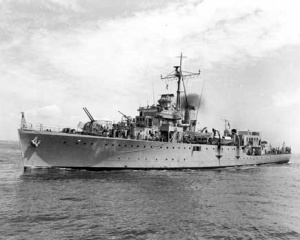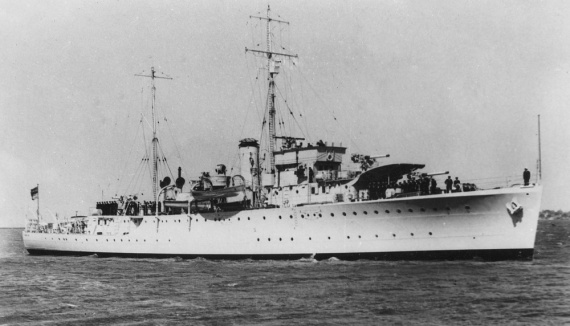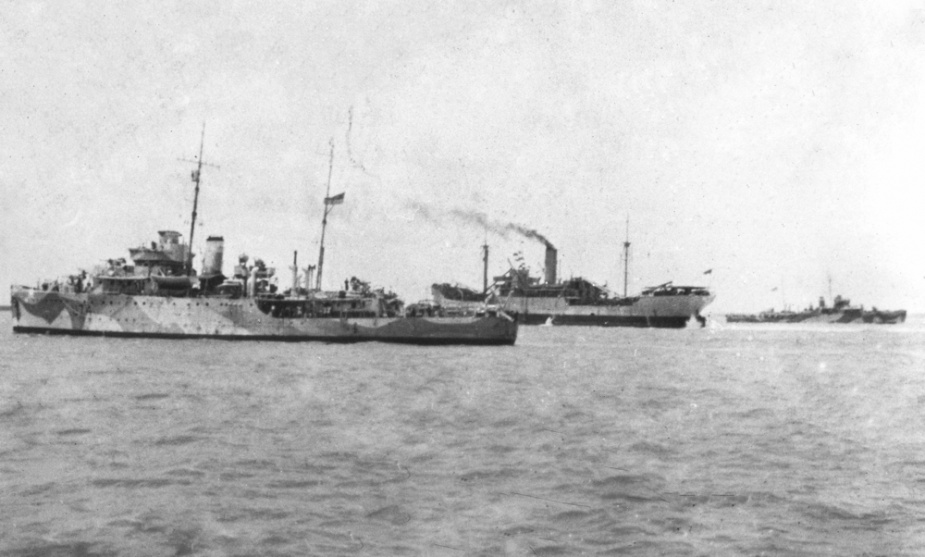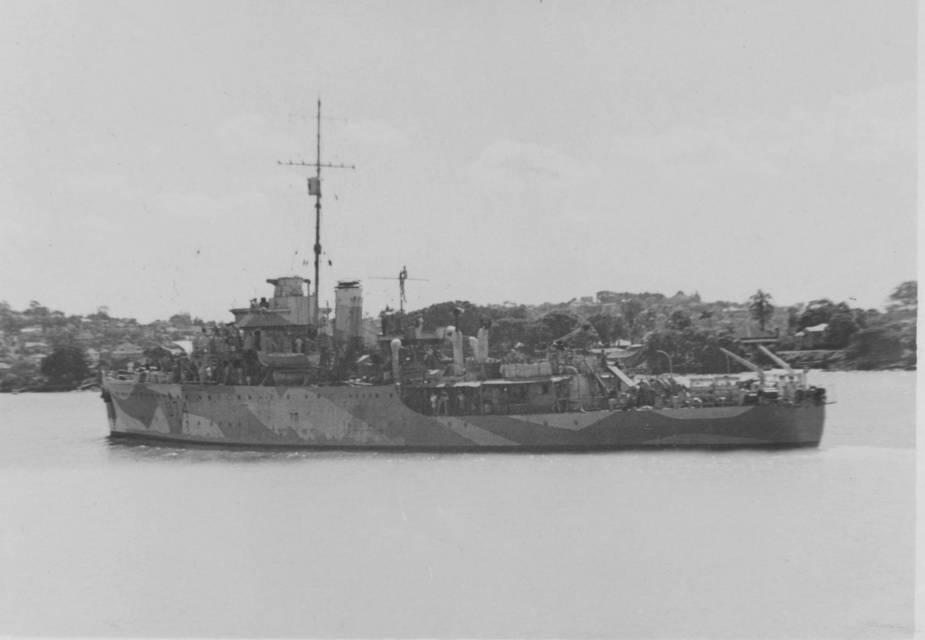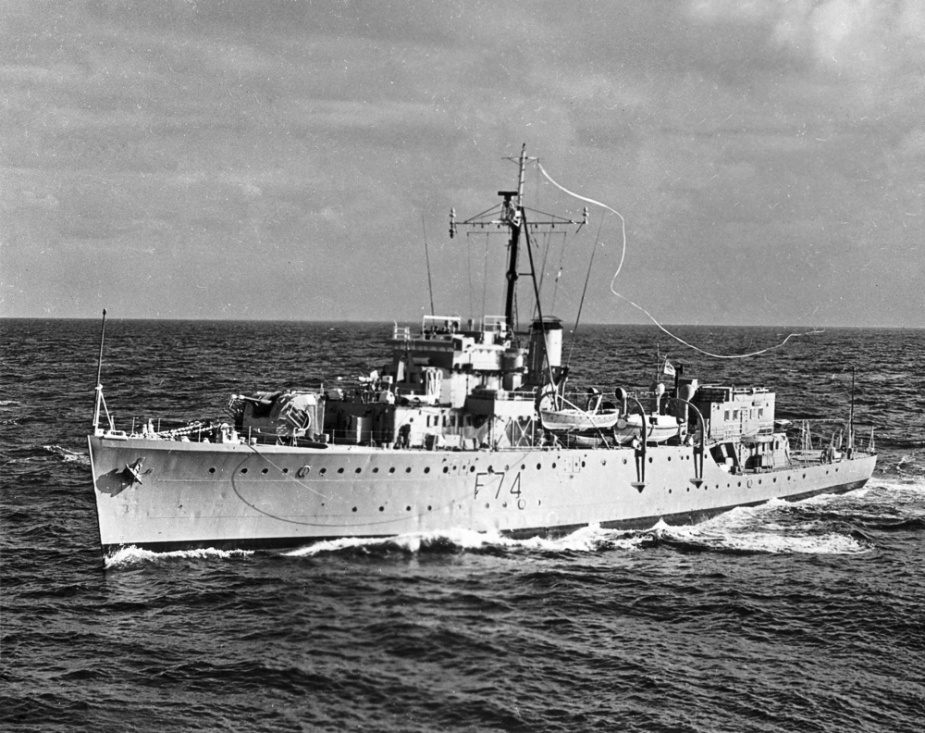HMAS Swan (II)
| Class |
Grimsby Class |
|---|---|
| Type |
Sloop |
| Pennant |
U74 |
| Builder |
Cockatoo Docks and Engineering Co Ltd, Sydney |
| Laid Down |
1 May 1935 |
| Launched |
28 March 1936 |
| Commissioned |
21 January 1937 |
| Decommissioned |
20 September 1962 |
| Dimensions & Displacement | |
| Displacement |
|
| Length | 266 feet |
| Beam | 36 feet |
| Draught | 10 feet |
| Performance | |
| Speed | 16.5 knots |
| Propulsion | |
| Machinery | Parsons geared turbines, twin screws |
| Horsepower | 2000 |
| Armament | |
| Guns |
|
| Awards | |
| Inherited Battle Honours | ADRIATIC 1917-18 |
| Battle Honours | |
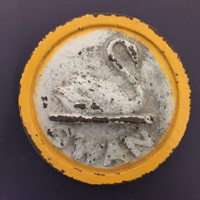
HMAS Swan commissioned at Sydney on 21 January 1937 under the command of Commander Roy R Dowling, RAN.
Swan's two years and seven months of service before the outbreak of World War II was spent mainly on the Australia Station. She visited New Zealand in April 1937, the Solomon Islands in September 1937, and in June and July 1939 she cruised to the China Station, visiting Timor, Bali, Batavia and Singapore.
Following the outbreak of World War II in September 1939, Swan was fitted out as a minesweeper and on 9 December 1939 became Leader of the 20th Minesweeping Flotilla, formed that day and comprising initially HMA Ships Swan, Yarra (II), Doomba and Orara. For the next two years, December 1939 to December 1941, Swan operated as a unit of the 20th Minesweeping Flotilla, sweeping in Australian waters. She was Flotilla Leader until October 1940, when the role was assumed by her sister ship HMAS Warrego (II).
Operations for the first eleven months were negative but in November 1940 the first enemy mines were swept. These had been laid by the German auxiliary minelayer Passat in Bass Strait off Wilson's Promontory. Subsequently in late 1940 and 1941, other mine fields laid in Bass Strait by Passat and by the German auxiliary cruiser PINGUIN off Newcastle, New South Wales; Hobart, Tasmania; and in Spencer Gulf, South Australia, were cleared by the 20th Minesweeping Flotilla. Swan swept ten mines.
In December 1941, following the outbreak of war in the Pacific, Swan was engaged in sweeping operations off Port Moresby in New Guinea and as a convoy escort. In January 1942 she proceeded to Amboina in the Moluccas to assist the civilian evacuation. There she experienced her first enemy attack when she was targeted by Japanese bombers. She escaped undamaged in spite of several near misses.
In February 1942 Swan was based at Darwin for anti-submarine patrols and on escort duties. On 15 February she departed Darwin as part of the escort of a convoy of four transports carrying troops for the reinforcement of Allied forces in Timor. Some 300 miles west of Darwin, however, the convoy and escorting warships were attacked by a force of forty-five Japanese aircraft and though no serious damage resulted, all ships were ordered to return to Darwin.
On 19 February 1942 Swan was at Darwin when the port was attacked by a large force of aircraft flown from the Japanese aircraft carriers Akagi, Kaga, Soryu and Hiryu, operating in the Timor Sea under the command of Vice Admiral Nagumo. This was the first and most severe air raid on Australian soil. Fortunately Swan was able to get under way without being hit but she experienced seven attacks and several near misses damaged her, killed three of her complement and wounded nineteen others. The following day she proceeded to Brisbane for repairs and a general refit.
Swan returned to seagoing service in May 1942 and for the following eighteen months, until October 1943, she was engaged escorting convoys between the Australian mainland and New Guinea. During this period she experienced several air raids in New Guinea waters but was not damaged again. In November 1943 a long refit commenced which kept Swan in dockyard hands until the end of March 1944. At this time Swan had steamed nearly 150,000 miles since commissioning.
In May 1944 Swan was assigned to New Guinea waters for escort and patrol duties, and as a fire support ship for military operations proceeding ashore. In the latter role, between August 1944 and May 1945, she carried out a series of bombardments of enemy positions in New Britain and New Guinea, and supported the operations of the Australian 6th Division at Wewak. During this period Swan also took over the operational control, at Mios Woendi, of the Australian escorts operating westwards of Hollandia engaged in convoying vessels between Biak and Morotai in the Halmaheras.
In June 1945 Swan returned to Australia to undergo her third refit of the war period. This work was in progress when Japan capitulated on 15 August 1945. In September 1945 Swan proceeded to New Ireland and there on 18 September 1945 embarked General Eather, General Officer Commanding the Australian 11th Division, and his staff. On board on the same day at Namatani, General Eather accepted the surrender of Japanese forces in New Ireland from General Ito, the Japanese Commander-in-Chief.
On 16 October 1945 the 20th Minesweeping Flotilla was reformed with Swan (Captain RV Wheatley RAN) as Flotilla Leader for mine clearance operations in Australian, New Guinea and Solomon Islands waters. This vital post war work kept Swan almost constantly at sea until 16 August 1948, when she arrived in Sydney having steamed 281,256 miles since commissioning. She paid off in the Reserve Fleet on 18 August 1950, without again proceeding to sea.
In October 1954, at Garden Island, Sydney, Swan passed into dockyard hands for conversion to a training frigate. The work was completed in February 1956 and on 10 February 1956, Swan recommissioned under the command of Commander Ronald J Robertson, DSC RAN, for service as a Cadet Training Ship. She was reclassified as a frigate and also fitted to operate as a survey ship.
As a training ship for the Royal Australian Navy's officer cadets and apprentices, and on survey duty, Swan steamed a further 160,000 miles in the period of February 1956 to September 1962.
Swan paid off for disposal on 20 September 1962. On 5 June 1964 Swan was sold to Hurley and Dewhurst, of Sydney, to be broken up. She was delivered to the purchasers on 18 September 1964.

